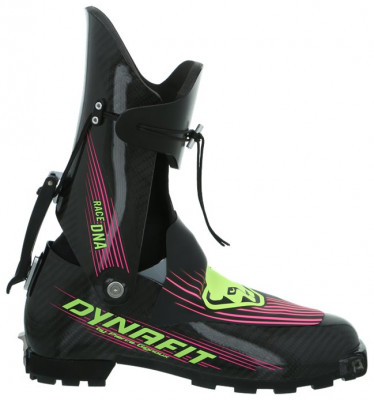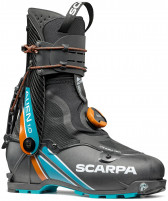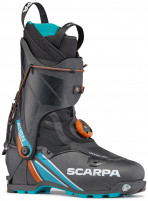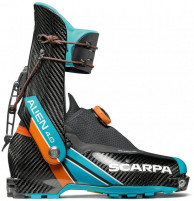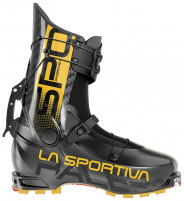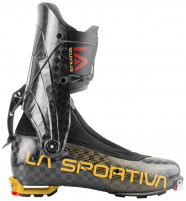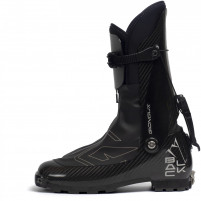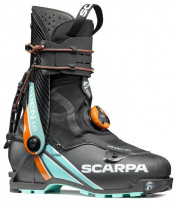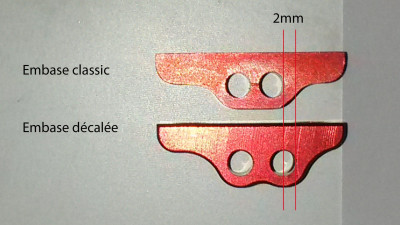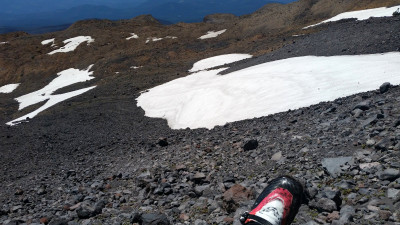Dynafit DNA Boot By Pierre Gignoux
What a partnership! Hand-crafted by the world-renowned Pierre Gignoux, the carbon DNA racing boot is distributed by world-renowned Dynafit. Long the most dominant player on the European racing scene, Pierre has taken weight and performance to a new extreme. Being the most dominant player on the North American backcountry scene, it only makes sense that Dynafit has embraced the extreme. They've also added a bit of comfort, with a custom designed liner that adds a bit more cush versus the stock PG version.
The carbon fiber DNA boot will have you checking in around the minimum weight allowed for ISMF races. At an astonishing 507 grams [27], it’s a wonder the boots can ski so well. It’s not a wonder that skimo races have been won with such lightweight gear, since the boot is specifically designed for the podium. We predict it will be seen on top of one soon.
- Ingenious walk/ski mode switch is a quick, one-motion system that causes no delay.
- Adjustable lower boot buckle holds your heel in place and provides ample support for skiing.
- Comes with bikini-style liner that provides a barrier between the carbon & your feet.
- Boot has 75 degrees of articulation which is probably more than your ankle has.
- Compatible with standard race bindings and the carbon fiber RC1 by PG.
Update 2015/16: Most notably the boots changed to pink & green (one of each). Also the shin pad is now riveted to the cuff to help avoid wandering. Note for production the upper closure is back to the cord found on the previous version (known as the "RC1 by Pierre Gignoux"), not the plastic clasp as pictured. See the picture of the red & white RC1 to visualize this.
Update 2019/20: Pierre has done it again! An internal lacing system has replaced the external buckle, and this featherweight boot got a paint job.
| Specifications | |
|
Weight |
507g [27] 560g [28] |
| Weight (pair) | 1014g [27] 1120g [28] |
|
|
Upper cord, ankle latch |
|
Boot Sole |
270mm [25] 280mm [26] 285mm [26.5] 290mm [27] 295mm [27.5] 300mm [28] |
|
Binding |
Tech + RC1 |
|
Cuff |
75° |
|
Forward |
12° or 18° |
| Specs Verified | Yes |
| Design | |
|
|
Full carbon |
|
|
Bikini |
|
|
Yes |
| Skimo Co Says | |
| Usage | Winning |
| Notes | Hand-crafted in France |
| Bottom Line | World class skimo boot |
| Compare to other Race Boots | |
Related Products
Questions & Reviews
Folks use these as training boots pretty often. If you're pushing them hard, you might wear through them, but they're very reliable as long as you keep an eye on the cords and screws and fix stuff preventatively.
The DNA by PG has a lower volume fit than the non-carbon DNA race boot. They are both on the slightly roomier side for race boots width-wise, but still relatively narrow by most standards. The carbon lower in the PG model wraps around the forefoot very snugly, almost like a sock, whereas the DNA has more vertical volume in the toes.
These are the same fit as the Race 400, yes. Essentially just a re-brand. So if you know your size in one, it will be the same in the other, and it will feel very similar.
Thanks!
Pietro
Sorry to hear of your blistering problem! These boots do have a wider heel pocket, which can interact with people's feet in different ways. Street shoe size isn't a great way to get a ski boot size unfortunately, but if you reach out to help@skimo.co, we can advise on how best to determine your correct size. It may be that the boots are slightly large, but it's hard to say without shell fitting you in person.
Overall, the fit on these is on the wider side for a carbon race boot, so somewhat similar in that regard to the PDG2 which was a wider race boot. However, it is much lower volume over the forefoot and instep. So with flat feet, medium to slightly wider width, you're likely in pretty good shape! They have a very low volume, sock-like feel over the toe box.
I am however looking for a a race setup and was wondering your thoughts on the fit in comparison to the DNA boot...
Kind regards
will
comment...
I really needed to slacken the angle, even with the adjustability it comes w/. I found that the extreme fwd angle made it really hard for me to ski aggressively and get any kind of recovery on the dh. So PG does sell a shorter (5mm) rear lever to change the angle. Hoping this is enough to make a difference.
question...
what kind of cord is used on the outer lever lock? PG does sell a replacement and the boots come with 1 replacement set, but I'd like to have more on hand (w/0 having to order from PG in France 15E). I've heard of guys breaking this mid race, not good, need to keep an eye on it and replace as needed
I just bought the DNA boots (pink panther, green hornet ^^) and i am really amazed by the lightness on the ascent and stiffness on the descent. The only thing is that the foam covering the cuff on the upper part is not reaching the top (or moved down, i cannot recall) and the very thin carbon edge is pressing on my calf in ski mode. After 2000-3000m of up and down skiing it becomes quite painful.
Any suggestions or similar experience ?
I guess I just had to get used to it because I don't feel any pressure point anymore ;)
Just one more thing I experienced:
The lacing’s slider/lock is not premium quality for a boot that expensive. I broke it on the left shoe just after 8 hours of use and on the second foot it is already wearing off. It can be easily replaced though, but still a bit annoying that it happened so quickly.
I ended up reverting back to the original PG slider: now after tightening it up all the way, I tie a bow on top of that (like with a regular shoelace) and it works out fine.
(I tried the same thing with the Salomon slider, and it also held in place with that setup, but just because of the depth of the slider it was harder to remove the bow at the end of the day.)
1) The foam on the 1st generation RC1 caused major chaffing on the back of my calf while skinning. Like burn blisters. The 2nd gen (pink and green) version don't cause this for me. Could be adjustment of the cuff or possibly just newer, slipperier foam.
2) Even with the salomon slider, I never could get it to tighten very well. I found cutting out the slider and just tying a simple square knot in the laces worked infinitely better. Not hard to untie either because of the kevlar cord.
-Eric
I hope somebody of you can help me.
I know that it's better to fit skimo boots before buying, but I've the chance to get used rc1's in size 26 for a very fair price.
Usually I have the pdg's in 27 from season 2015. They fit very well. Will the rc1's fit in 26??
Greetings from Austria
Flo
Background on product familiarity: I haven’t used them yet on snow … but I’ve probably spent more time setting them up than some skiers have actually skied with their boots! Other race boots I have used for comparison include almost half a million vertical feet on the Scarpa Alien 1.0 and almost 900,000 vertical on the Dynafit EVO.
First, the first impressions out of the box: Although Dynafit simply rebranded Pierre Gignoux’s Race 400 / Ultimate, PG’s innovations go beyond just substituting carbon for plastic in the lower shell. My size 26 is slightly under spec: even fails the ISMF weight min. And only a few oz / foot more than xc boots & socks … for our 5 yr old daughter!
Shell fit is wider than Alien 1.0 or EVO yet somehow still feels reasonably snug. But the bike-style instep buckle’s effectiveness is limited by the lower shell’s extreme rigidity, and the lacing’s slider/lock is also questionable (although replaceable with a Salomon “Quicklace Kit”).
Interior length is true to size, but toe box height is so minimal as to make the front few cm almost unusable: on the Skimo Co boot page, every other boot has a front end more like a minivan, whereas the RC1 is pointlessly low slung. Fortunately a dremel and scalpel removed enough excess foam from the liner to accommodate my big toes.
And that liner comes up only just above the ankle, so very easy on/off. The user manual advises only a stack blower for molding, but my liners came out perfectly from my convection oven.
The shell leaves much of the liner open to the elements, and the partial liner doesn’t offer much protection either. Without a race suit’s integrated gaiter, you can try tucking the front edge of your pant legs under the buckles. The PG website offers a proprietary gaiter, plus my Scarpa Alien gaiter seems okay.
Second impressions, in use (or simulation thereof): In walk/tour mode, the upper cuff offers no discernable resistance and over an essentially unlimited range of motion. The vertical lever engages very easily for rearward and lateral support that are as expected from all that carbon combined with only the most minimal slop in the tour/ski lever assembly. Forward stiffness is somewhere in between the Scarpa Alien 1.0 versus Dynafit EVO, so if anything more than you need for fast & light backcountry skiing.
And as with all these boots, forward flex is highly sensitive to the upper cuff cord’s tightness. The RC1 lacks the quick adjustability of the EVO’s velcro strap for smaller adjustment. But the RC1’s clove hitch is far easier to adjust than both the Alien 1.0 figure eight on a bight and the EVO sheet bend or double fisherman. (For 2015-16, the renamed DNA boot not only gets an asymmetrical color scheme but also the PG “Black” model’s buckle-style cord adjustment.)
Also as with all these boots, forward flex is highly sensitive to forward lean: too much will not only shift your hips back and strain your quads yet also make the flex feel softer. The RC1 offers four different positions, adjusted via two different attachment points for the vertical lever’s pin combined with two different orientations for the pin’s attachment block. Unfortunately even the most upright of the four different positions was still too far forward on my particular sample of my size 26. Fortunately PG sells an attachment block further offset by 2mm, which translated into a 2cm difference in knee position (perfectly matching the more upright of the EVO’s two positions).
Like the PG Ultimate boot, the toe sockets are gouged out on the bottom, which looks similar to the Dynafit “Quick-Step-In” sockets. But it doesn’t have this benefit and is instead for the PG Ultimate carbon fiber binding (also rebranded by Dynafit). Despite previous incorrect information to the contrary, the RC1/Ultimate interface is compatible with standard bindings. But first you might need to (depending on the binding model) cut/grind away excess rubber in the toe to provide enough clearance for the wings (although many other boots share this issue).
Next you need a ~5.5mm heel gap for a typical race binding that specifies 4mm. The RC1 heel interface is perfectly flat, without the typical ~1.5mm of curvature. Hence a 4mm RC1 gap equals pin penetration of a ~2.5mm gap with any other boot. Although you might get away with that in any other boot, the RC1 heel slots are very short, and also all metal with no give. So when set up with a 4mm gap, the RC1 will not release laterally, period.
Finally, even with a larger gap, my particular boots needed to “work in” the toe sockets with at least several twist-outs in each direction. The easiest way is probably for a vise (or somebody else) to hold down a ski, and with the boot in your hands (gloved for the sharp edges), keep entering the binding toe (heel pins disengaged) then twisting out. Measured with a ski binding torque tester, values started off nearly unreleasable then became normal after a few twist outs. The sockets still looked the same, so whatever wear occurs from this is very small (yet very important).
Third impressions, for long-term durability: PG boots previously acquired a reputation for hardware/fastener vulnerability. I don’t know whether that reputation is still deserved, but with carbon rigidity plus minimal design slop, something has to give in the proverbial match-up between the irresistible force versus the immovable object. The good news is that all the hardware is designed to be readily replaceable (even in the field), and carbon shells can be repaired. The bad news is that warranty service is via France (not Dynafit/Salewa in Boulder), but PG has a strong reputation for responsive customer service (even setting up shop at Euro races). Off-snow, the rubber outersole at least looks durable, although the carbon lower shell probably doesn’t fare well in the first match-up of skimo’s version of rock-paper-scissors.
(For other bindings, based on further experimentation, I think 4.5 to; 5.0 is about right. But the typical 4.0 with a typical binding essentially locks out lateral release.)
The PG was that way right away.
The Alien 1.0 needed to have that plastic stretched out first b/c otherwise the ledge was either jutting in to create lots of pain or else too loose.
(Before I had it stretched, I essentially moved the ledge up a few mm by removing the little foam insert inside the shell and replacing it was something I little thinner.)
- Downhill performance for “fun” skiing on “real” skis is very sensitive to upper cuff tightness: too loose = little sloppy; too tight = total rock. Upper cuff cord is fairly quick & easy to adjust with bare hands, especially inside. (Impossible with gloves.) For racing though, even if the cuff is a bit loose, still more than enough control for typical fast skiing on race skis when you don’t care about style points.
- Instep buckle can freeze from wet snow changing over upon cold temps, but only a very rare and brief annoyance at the end of a day. (Always easy to tighten up the buckle during the day even if frozen.)
- The previously free-floating external tongue on my 2014-15 model has since been integrated into the carbon fiber upper cuff, which should eliminate another little minor annoyance I’ve experienced.
- Liners have some seam placements relative to the somewhat harsh carbon fiber shell’s interior that render them susceptible to wear, so requires periodic inspection combined with Speedy Stitcher Sewing Awl and occasional reapplication of those little liner patches (i.e., that you’ve been saving from all your prior ski boots that rarely required them). Then again, the PG website has prices so low for replacement liners that maybe they’re just meant to be disposable like running sneakers?
- I temporarily repaired a broken sheath on the interior lacing cord by knotting together the good ends. Replacement with Salomon Quicklace cord should be technically easy yet tedious as the lower shell’s permanently affixed cover hinders interior access. Also some wear and minor holes on that cover from the instep buckle, though duct tape will be fine for patching that over eventually.
- Upper cuff pivot/rivet is still perfectly tight.
- Attachment point for the walk/ski lever developed some serious slop. However, this is *probably* the result of my replacement attachment block (to reduce the forward lean) combined with my reluctance to use Loctite Red. Instead I wimped out with Blue, which was ineffective. But with Vibratite (which is more like sludge, rather than glue) combined with ~1mm LDPE shim to increase tension, one boot now stays tight and the other requires only a little periodic Torx 20 encouragement to stay tight.
- After ~1,800’ vertical in off-snow race bootpacking over a mix of dirt, grass, rocks, etc. plus some random walking about in parking lots, etc., boot sole rubber still shows zero wear. In anticipation of more serious rock scrambling, for the spring & summer I’ve created a protective rand (as inspired by a prior PG model) with mastic tape.
- As for the big question, ascent speed for racing, hmm, anything lighter is of course faster, but how noticeable? I think the big advantage is toward the end of a longer course when you really dig down deep yet you’re already tired -- perhaps I can attribute edging out some rivals that way in three races this season. But for training, especially only moderately long solo outings, when I go back & forth between these vs more normal race boots (for another 141,000’ so far this season, as compared to 231,000’ on the RC1/DNA), it’s not a dramatic or perhaps even immediately noticeable difference.
"Fortunately PG sells an attachment block further offset by 2mm, which translated into a 2cm difference in knee position (perfectly matching the more upright of the EVO’s two positions)."
can't seem to find anything like this on PG website. thoughts?
Lots of liner replacements and lots of minor repairs, but nothing really exotic or advanced. Functionally though, they're still essentially good as new.
Given all the liner toe box foam I had to shave down to get my ~265mm foot into the sz 26 shell, I've now relegated them only to warm temperatures, but that just means that they get even more abuse -- typical example shown in the picture.
I suppose that means that on a per-vertical basis these have been my least expensive ski boots ever!
They are actually a lot stiffer than my Dy.N.A. boots. I prefer the rear throw lever over the Dynafit side lever on the Dy.N.A.s - it's quicker and less prone to getting bashed on rocks. It also means cutting fewer holes in your ski suit so less snow gets in the cuff. The full rubber sole seems to be pretty solid but I am still careful running around rocks. I opted for the low-tech binding rather than the RC-1 binding and it works well with a little trimming of the rubber under the toe. CAMP Rapid 290 crampons fit well after cutting off the metal heel tab.
I only took off one star because I am not 100% stoked with the instep lacing system. The slider that came on the laces barely worked so I replaced the slider and laces with a Salomon quick lace kit and that works pretty well. The Sidi style instep strap bunches up the top of the boot and just digs into my foot. It also gets clogged with snow that freezes into ice and makes it so I can't get the boot off. Really though, this isn't a huge issue and probably does not deserve losing an entire star.
Overall, it is crazy light for going fast uphill, fast in the transitions, and very stiff and skis well on the downhill. That's all I want in a race boot.
Earn store credit by writing reviews. Learn more.






